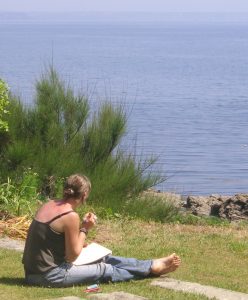
ALASTAIR MACKENZIE is a travel journalist and social media commentator. He is Social Travel Editor for Traveldudes.com and blogs at Mechtraveller.com. He teaches for us on Travel Blogging for Beginners.
Is there still room in the marketplace for new travel blogs?
There IS still room in the marketplace for new travel blogs, but they have to be niche. Unless you are already a celebrity, it’s almost impossible now to rise above the masses with a general blog about backpacking, or luxury travel, or foodie travel. In those broad sectors, you are competing with established bloggers who have been building their audiences for almost a decade. That’s a lot of catching up to do.
So, take your area of interest/expertise and narrow it right down. Don’t blog about backpacking, blog about backpacking in your wheelchair, and if you can, go narrower than that! Blog about backpacking in South America in a wheelchair. It doesn’t matter that your audience is small, it will be an audience that tourist o ces, specialist brands and equipment manufacturers/ retailers will pay to reach. I well remember a few years ago a friend, who is a deaf travel blogger, suddenly appearing in an advert in the cinema and TV for Apple iPads! (Cherie King, youtube/ watch?v=vRCXQ6phV8k) She didn’t have a huge following then, but she had an engaged audience and that’s what got her noticed and made Apple want to be associated with her.
Can you give us two practical tips for building a successful site?
1: Find a domain name that you can use not only for your site but for ALL your cross-platform branding. Using my example above, if you can get WheelieBackpacker.com (just thought of it – and it IS available!), can you also use @wheeliebackpacker on Instagram, Facebook, Twitter, Pinterest, YouTube, etc? Remember not to be too restricted. The travel blogosphere and industry is littered with brands that outgrew their name. For example, @SAmericanWheelieBackpacker is new… until you’ve covered most of South America on your wheelchair travels, built an audience and now they are asking you to cover Europe as well, or until you’ve grown older and want less backpacking and more luxury!
2: Pay attention to SEO. That doesn’t mean you have to write unnatural clickbait headlines all the time. I hate them, so I don’t! You should, though, make sure your posts are search-engine friendly: use sub-headlines, make sure photos have descriptions in the ALT attribute (and use descriptive filenames for them), check regularly for broken links.
If you are on WordPress (why wouldn’t you be? Most of the world is!), use a plugin like Yoast to keep your blog search-engine optimised. That will keep you in line with your competitors. To get ahead of them, build a profile of your target visitor (who are they, how old, what job, married, kids, hobbies, activities…?), then use a keyword-finding programme to search for competitive words and phrases that can reach them and aren’t being used by too many other websites.
How would you monetise it?
Don’t just think of on-site monetisation. Most professional travel bloggers earn their money, or a large part of it, off-site. The blog is where their authority lies and it earns some money from advertising, a liate links or sponsored posts (always declare them!). But their biggest income streams come from jobs as an expert speaker, travel brand consultant or brand ambassador.
It is possible to earn a living from just on-site advertising and a liate links, but rare. I know one blogger (Conni Biesalski, theprofessionalhobo.com/ nancial-case-study-conni-biesalski-travel-blogger) who now earns €84,000–120,000 per annum from Amazon sales and her books, but she started out with a range of income streams.
The other important revenue stream for pro-bloggers is through marketing campaigns and sponsored trips, either solo or with a blogger collective. Destinations and brands will pay for specific coverage in specific blogs. Bloggers retain editorial control, but are expected to achieve targets such as a certain number of visitors to a campaign landing page on the client’s website. Usually there are a set of ‘deliverables’ in the contract too, such as three posts on your blog, at least ve tweets daily, four Instagram posts, one Facebook Live video, a hosted Twitterchat a week after returning, and the rights to use a selection of your photos.
What’s the next big thing for travel blogging?
Pivoting publishers. Many of the social media organisations that appeared over the last decade in the travel sector are beginning to ‘pivot’ or morph into other roles. For example, Travel Conferences turning into Communities, then into Social Media Marketing organisations. Or Blogger Communities turning into Skills Development Agencies and Conferences. I can see a number of these moving into the space being vacated by traditional publishers. It won’t be long before Travel Blogger Marketing Collectives, Travel Influencer Communities, and other Digital Travel Media organisations, start to become Travel Publishers.
Extract from The Travel Writer’s Way, copyright Jonathan Lorie 2019.
